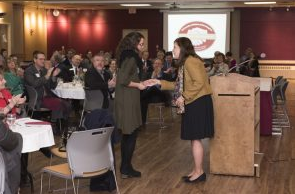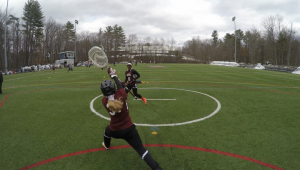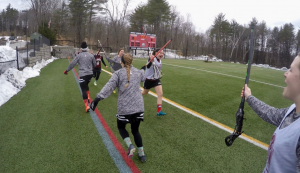
Apr 20, 2017 | Feature |
By Nick Bray, Staff Reporter

Woody Hanstein. (Photo Courtesy of UMF)
There probably isn’t anyone in the state of Maine with a resume quite like Walter “Woody” Hanstein’s. In the fall semester, it isn’t unusual for Hanstein to work a full day at his law practice, then head down to the rugby pitch at Prescott Field to coach the Women’s rugby team, then to a classroom at UMF to teach his weekly law seminar.
Hanstein’s law career began in 1979 when he graduated the University of Idaho with a Juris Doctor (JD) degree. Hanstein is a former navy JAG and former assistant district attorney for the state of Maine. He began his own law practice in 1987 in Farmington.
Throughout his time in school and while in the Navy, Hanstein played and coached rugby. In the late 1980’s, Hanstein coached rugby at Colby College. Hanstein approached UMF’s athletic director in the early 1990’s about starting a rugby team. His law partner at the time, Pat Joyce, had a son, Kevin, who was currently attending UMF. “Kevin had played football at Mt. Blue,” Hanstein said. “So he and a few of his friends and myself started the team in 1991.”
The UMF rugby program is known for being successful but they are even more known for their unique green and gold uniforms. “We have almost exclusively played in the colors of green and gold because it was the only set of rugby uniforms available just a few days before our first game,” Hanstein said.
Starting as the coach of the men’s team, Hanstein switched to coaching the women’s team after their coach left and the assistant coach became the men’s head coach. President and Captain of the Women’s rugby team, Emily Gray, has been involved in the team her entire time at UMF. “Woody teaches you a lot about the game,” Gray said. Not just the skills but he wants you to know how the game works and helping to increase players’ rugby knowledge. “
Hanstein has also been teaching law courses at UMF since 2000, drawing on his experiences as a lawyer to educate students about the legal system. Hanstein believes that using real life cases to make points about the legal system makes it easier for students to relate and understand. In addition to playing rugby, Emily Gray has also taken Hanstein’s law class. “Woody always has little anecdotes and they always come up when he’s teaching or coaching,” Gray said. “He coaches a lot like he teaches, by teaching by example”.
Cadi LaCourse is another student who took Hanstein’s course. LaCourse agrees that Hanstein’s teaching style helped her learn more about the legal system. ”It was much more interesting than reading a text book,” LaCourse said. LaCourse believes she learned more because he is a practicing attorney. “A lot of the course was Woody teaching us to think for ourselves, to use the facts and evidence to support our theories and opinions.”
His law and the legal system course provides an overview of the justice system, but also puts an emphasis on civil rights.“It’s a fine line between informing people about their rights, and explaining to them how to get away with breaking the law,” Hanstein said. “I think a course like Law and the Legal System should be mandatory before students finish high school. They should be able to understand their basic legal rights.”
Hanstein says several students who have taken his course have gone on to law school and are now practicing lawyers in Maine. “I recently saw an assistant district attorney in Kennebec county who I had to beg for a plea bargain, and he took my class,” Hanstein said. “I was trying to remember if I had been nice to him.”
In his spare time Hanstein pursues other interests including fiction writing. He is the author of six legal thrillers featuring small town lawyer Pete Morris. In addition, Hanstein serves as a member of the Titcomb Mountain Ski Patrol. He also directs the Smiling Goat Precision Juggling Corps. “I like to say I am the international founder of parade marching juggling,” Hanstein said. “Nobody else would have bothered to try.”
They march in local parades including the Wilton Blueberry Festival and the Chester Greenwood Day parade. To entertain lawyers at the bar association, Hanstein created a youtube video titled “Juggling for Lawyers.” Hanstein’s brief, four minute tutorial was filmed in the historic Franklin County Superior Courthouse.
Hanstein knows he made the right decision in moving to Farmington. “After getting out of the Navy I could have been an ADA in Portland, Machias, or Farmington,” Hanstein said. “My wife and I came to Farmington and we knew right then this was the place for us. We were right.”
Between his involvement in Rugby and his teaching, Hanstein spends more time with people who are significantly younger than he is than people his own age. Hanstein believes this keeps him young. He even takes life lessons from his students. “You take less for granted. When you see someone see something for the first time that you’ve seen forever, you just appreciate it that much more.”
Through his capacity as coach and teacher, Hanstein has had the opportunity to serve as a mentor to many students. “Woody is an adult in my life I look up to,” Gray said. “He is always ready to help anyone on the team, with anything. If I have an issue I’m not afraid to call Woody and talk about it.”

Apr 20, 2017 | Uncategorized |

Cote acknowledged for her winning design. (Photo Courtesy of UMF Website)

Cote’s winning design. (Photo Courtesy of UMF Website)
Recent winner of the Partnership for Civic Advancement sticker design contest, UMF student Samantha Cote, was acknowledged at the Partnership’s Annual Recognition Dinner last month. According to the Partnership’s website, Cote’s design was chosen because it best conveyed the purpose of the organization while also incorporating UMF colors. Cote’s work was well received by the attendees of the event. Congratulations!

Apr 20, 2017 | Sports |
By Sarita Crandall & Marissa Chamberlain, Contributing Writers

Senior members of the 2017 UMF Women’s Lacrosse Team. (Photo Courtesy of Patty Smith)
It was looking like it was going to be a beautiful spring afternoon to play a game of lacrosse, but despite the ominous weather that grew over the field at Thomas College, the Women’s Lacrosse team never gave up and defeated Maine Maritime Academy (MMA) with a final score of 10-1. The rain added a dramatic component to the game, which was considered a home game for the Beavers despite the necessity of an alternative venue due to the conditions of Prescott Field.
As the Beavers warmed up before the game, Coach Beth Lebel, who is in her first year as head coach of UMF lacrosse, noted that this was going to be a game that they needed to compete. “MMA is going to battle, they’re physical, they’re fast and athletic, but we are too. If we can just connect our passes and transitions, then I think we should compete fairly well,” said Lebel.
Carly Raymond, a key player for the Beavers, said that on game days it’s an adrenaline rush. “I can’t focus in school, can’t sleep the night before,” Raymond said enthusiastically, “It’s all nerves and excitement!”
At the blow of the whistle to signal the start of the game the intensity was there for both teams, but UMF was more in control of the field and scored a goal in the first three minutes. The first goal was scored by Danielle Conway and assisted by Raymond.

UMF Women’s Lacrosse players warm up for their game. (Photo Courtesy of Patty Smith)
It didn’t stop there for UMF. They continued to send four more goals into the net by the end of the first half. MMA was becoming discouraged by the control, composure, and finesse that our Lady Beavers were showing during the game. Some MMA players were becoming aggressive and unsportsmanlike out of frustration. Raymond mentioned that many teams are aggressive on the field and can get out of hand if the refs don’t set them straight. “Our team keeps our heads on our shoulders and fights through, we rarely fall to their level of checking and pushing,” Raymond stated proudly, “UMF in general has great sportsmanship!”
Sportsmanship and work ethic are two traits the Women’s Lacrosse team represents very well for UMF. The Beavers goal as a team was to have a positive team culture, and this was evident in practice the night prior to their game against MMA.
With a winter that seemed to last forever and piles of snow speckled with dirt still covering the UMF campus, many spring athletic teams can be found practicing anywhere they can find dry ground. A line of lacrosse sticks and equipment tucked behind the sidelines and a cluster of athletes with UMF maroon shorts and Beaver lacrosse tanks came into view when walking into the last two courts. Coach Lebel practiced her behind the head shot while the team warmed up. The first shot flew wide and landed a couple of laughs from her team. “Practice makes perfect!” she yelled. This seems to be the motto the Women’s Lacrosse team goes by.
After going for a two lap warm up run, the team came back to the court to complete their routine dynamic stretching, strength exercises, and basic skills. The team’s personality can be described as encouraging, lighthearted and supportive, all while having a competitive, intense edge. “They’re fun to be around,” said Lebel, “and they also know when it’s time to put their game faces on and work for everything.”

The 2017 UMF Women’s Lacrosse Team. (Photo Courtesy of Patty Smith)
The team had just come off of a couple of losses over the weekend at New England College and Castleton ending a four game winning streak, but these athletes did not come to practice that Tuesday to dwell on those losses; they came to work and prepare for their next conference matchup against the MMA Mariners.
Despite the adversities caused by a Maine winter and being a young, fairly inexperienced varsity team, the Beavers have had a successful season so far with a record of 5-3. Coach Lebel doesn’t look at having players who are new to the sport as a hardship though. She explained that newcomers make positive contributions including work ethic and excitement to learn and get better at the sport.
Some of the success of the rookies definitely comes from support from the more seasoned players. Rhi Jackson, one of five seniors on the team, attributes this to a lot of team bonding and Coach Lebel’s “Big Beavs and Little Beavs” idea. Lebel paired each upperclassman with an underclassman. The “team buddies” give each other gifts and pump each other up before games.
Looking towards the future of UMF Women’s Lacrosse, Lebel hopes to expand the program further. “We will continue to take players who haven’t played before and those with limited high school experience, along with veteran high school and club lacrosse players,” said Lebel. “Girls’ lacrosse in Maine is expanding rapidly and I’m looking forward to continuing to grow the game with my team and program.”
Needless to say, their hard work did not go to waste. The Beavers came out even stronger in the second half of their recent matchup against MMA, scoring five more goals to assure them the win. Whenever a goal was scored there seemed to be a new energy on the field for UMF. For Raymond when she scores—during the game she acquired two goals—it’s a sigh of relief. “All the work to get to the net finally paid off!” The next game for the Beavers will be their Senior Game, Saturday, April 22 at 7 p.m. at Thomas.
Apr 20, 2017 | News |
By Lindsay Mower, Staff Reporter
In 2017, humans in modern society find themselves in a contemplative state of addiction to a diversity of electromagnetic field (EMF) sources: i.e. mobile technology, which ex- poses them to various doses of radiation on a daily basis. This public health phenomenon, a large topic of discussion among UMF students in the classroom with Community Health Education professor Dr. Maurice Martin, can be supported by an article published online in 2012 by Myung Chan Gye and Chan Jin Park which examines the effects of EMF exposure on the reproductive system.
The findings of the article indicate that EMF exposure alters reproductive parameters of the human body, including male germ cell death, the estrous cycle, reproductive endocrine hormones, sperm motility and overall pregnancy success, among other areas. Of course, these biological effects differ according to frequency and wave, strength and duration of exposure.
Martin believes the implications of the article’s findings are of immediate concern. “A reduction in testosterone has the effect of making it a much more androgynous society, which is more likely to espouse a feminist paradigm,” says Martin. “It throws the balance of nature off. I think that masculine behaviors, that might not be positive all the time, certainly are needed at some points.”
Like any public health concern, there lies a political aspect to this invisible epidemic: the 1996 Telecommunications Act crafted under the Clinton administration, with help from The Wireless Industry, which states that no health or environmental concern can interfere with the placement of telecom equipment, such as cell towers and antenna.
“There was a motion put on the floor of the house in Washington saying that we really need to study the effects of electromagnetic radiation further. The house Republicans immediately came up with an embargo, or a block, against any reports that could identify health issues to stop the construction of cell towers and all mobile technology,” explains Martin.
For public health research purposes, this basically resulted in the federal government being prohibited in studying the effects of electromagnetic radiation if they want any kind of funding at all. This is why no research can be seen from the Centers for Disease Control and Prevention (CDC) or the National Institutes of Health (NIH). The 1996 act is still in place today.
In addition to EMF exposure remains a very visible health effect caused by modern society’s addiction to technology: a lack of physical activity. “There are only so many hours in the day. If you’re spending eight of those online, you don’t have much time to be physically active at all,” says Martin, warning that it should come as no surprise when we see the increased development of chronic disease in the near future. “We are going to start having fewer years in our life,” says Martin.
Acknowledging the reality, which is that most of our jobs and livelihoods depend upon this type of technology, Martin also believes it’s highly unlikely that we’re going to back up from it. “The type of addiction to technology that is seen in millennials has developed through the use of screen time from infancy, onward. I believe that there are pathways in the brain that are deeply rooted, and that have now been formulated for digital processing,” he says. “Myself, I’m not that interested, but I think that when little children learn it early on, it just becomes a habit. I don’t think that they can help it.”

Apr 20, 2017 | Feature |
By Jessica McKenna, Contributing Writer

Artist Shane Cynewski stands next one of the sculptures from his body of work “Investigating Undesirability Through the Unmonumental.” (Photos by Jessica McKenna)
A semester’s worth of hard work came to an end on April 13th with the opening of the Senior Art students’ Thesis Exhibition, “Five to Nine.” The sun slowly disappeared from the sky over the UMF campus casting a faint blue shadow as four of UMF’s Senior artists made their way down the tarred pathway to the small art gallery near the green. The artist entered the compact gallery where their names were printed on the wall brightly lit by a spotlight for all to see. Each floor was a mixture of different artists creations using various media to convey their work.
For Senior artist Gabrielle Ganiere the exhibition signals an end to her journey at UMF. “This is my last big thing,” said Ganiere. “I do have a symposium talk about my artistic process but this is the pivotal moment.”
Ganiere’s work stood out amongst her peers as her media consisted of pantyhose, trash bags, yarn and other fabrics that brought a softer tone to the exhibition. Each piece embodied a creature of sorts with some invoking memories of childhood stuffed animals or beloved pets, while others made spectators think twice before they took a step closer. “I want them to be confused on how they feel,” said Ganiere, “Do they want to get close or stay away, I like to see people’s expectations of each piece.”
A pink mattress laid against a wall with plastic milk jugs, a wooden chair, and a blond wig attached to the once familiar object. Artist Shane Cynewski’s body of work made spectators feel as though they had entered a home but the everyday items they encountered had changed.
“I used sculpture as my media and domestic objects, so items you could find in a home,” said Cynewski. “The reason I use those objects is I try to inverse the desirability of them.”
Each sculpture turned household items into unknown objects to the viewer with a changed purpose. Cynewski and his classmates had been preparing for the show since the fall of 2016 starting with senior seminar. “We wrote our thesis in the fall and then started working on our body of work,” said Cynewski. Each Senior spent their spring semester finishing their body of work, participating in faculty critiques every few weeks and writing press releases and artist statements.
As the crowd grew larger the artists were surrounded by friends, family, and professors sharing words of congratulations and acknowledgments of a job well done. Spectators moved from piece to piece at a glacial pace taking in as much as they could trying not to miss any part of the artist’s message. UMF President Kathryn Foster spoke with an artist in the middle of the Emery Community Arts Center flex space, and followed her to a piece of work to delve into the meaning and the artist’s process. “It’s thrilling to see the culmination of so much thought, hard work, and creativity!” said Foster.
The exhibition continues through May 13 in both the UMF Art Gallery and the Emery Community Arts Center showcasing the works of the six senior UMF artists.






